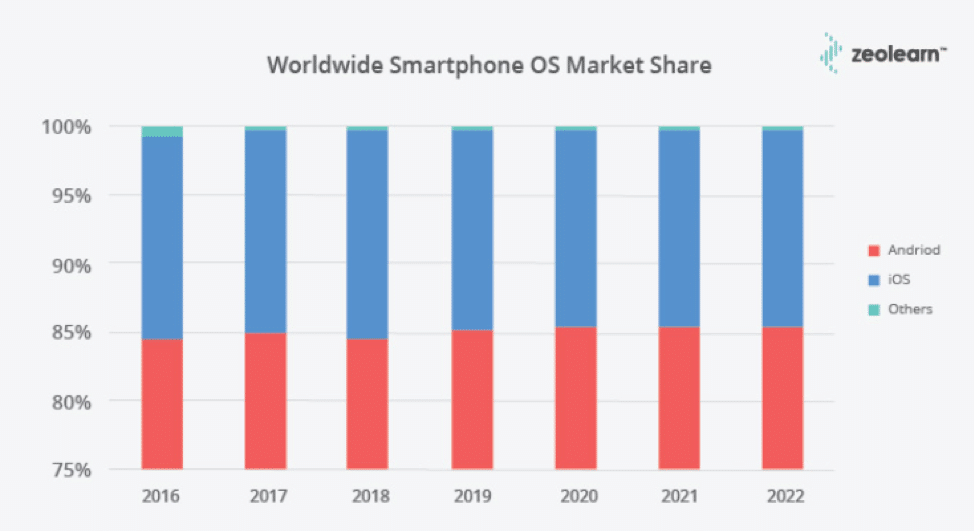Is Flutter a robust platform for mobile app development?
Is Flutter a robust platform for mobile app development?
Once upon a time, most of us who are over the age of 35 said back in the day that we couldn’t see the usefulness of a mobile app, or maybe that we thought 3-5 apps on your phone was more than enough. Now, mobile apps are as much a part of life in the modern world as the internet itself. We interact with every level of society through our applications, and as a result the need for companies to develop their own apps has never been higher.
Should you use native or cross-platform app?
Native apps are apps that are designed for a single platform, using the ideal coding language for that platform. This typically means something like Objective C and Swift for iOS compared with Java for Android. But a native app designed for Android in Java wouldn’t function on iOS, or vice-versa. Cross-Platform apps are compatible across multiple platforms, which in practice typically means both iOS and Android as they have the market absolutely cornered between them, as the graphic from IDC shows¹.

Cross-platform apps tend to be significantly cheaper, with a budget of up to 80% that of native app development. Development time is likely much faster than with native apps, which have to be written from scratch. Cross-platform apps obviously can reach a larger audience, given the fact that they’re written for multiple platforms, and because the platforms are web based, they’re easier to develop. The problem with cross-platform apps is that, typically, native apps are viewed as superior in terms of performance and user experience. They’re viewed as faster, more responsive and less likely to crash, whereas cross-platform apps have numerous performance issues. Well, that is until…
Flutter: The new kid on the block for cross-platform apps
There are a large number of cross-platform mobile app development frameworks, including appcelerator, ionic, PhoneGap, Monocross, React Native, Mobile Angular UI, Xamarin, and more. Flutter is Google’s open-source UI software development kit, and despite its relatively new entry into the market (Flutter 1.0 was released in December, 2018, or less than a year since this writing), it’s already arguably the world’s most popular multi-platform mobile app development framework.
This popularity is due to a number of factors, but ultimately it comes down to its ability to essentially offer something close to a native app experience for free.
Flutter at a glance
So quickly, just looking at Flutter, what all does it feature?
● Free, Open-source
● Rendering Engine Use C++
● Based on Dart programming language
● Provides its own widgets
● Reactive Programming Architecture
● Fast Performance
● Support for development on Windows
● Android Studio and Visual Studio Code
● Support more Firebase APIs
● Stateful Hot Reload
● Support inline video, ads, and charts
● Good documentation
● IntelliJ
● strong support from Google and community

Hello World in Flutter.
What are all the benefits of Flutter?
● Fast-paced Development Process
Apps can be built remarkably quickly, faster than many other frameworks. Flutters compilations patterns basically fall into two categories:
– Just In Time Compiling
Also called “JIT” for short, this allows you to dispatch code as it changes to the user end of things, without having to take into account the what machine the user is on.
– Ahead of Time Compiling
Also called – you guessed it – AOT for short, this is the fastest form of compiling, allowing code to be executed immediately. For code that requires a lot of computer or graphics rendering, AOT is a lifesaver and provides the best user experience.
● Google Support and Native Support
Because Google is such a massive brand and because the framework is open source, there are literally thousands of developers all over the world who help to support development, including Google’s own team of course. This helps you to gain access to native features, which can be easily integrated into Flutter – all of course significantly faster and more easily than actual native development would be.
● Reusability of Code
The widgets that come with Flutter mean that a single code can be reused to build apps across multiple platforms. There’s just about no need for unique code to differentiate between platforms.
● Compatibility
As we mentioned, this is a standard criticism of cross-platform apps. Performance issues related to compatibility are a large reason that many developers opt to go native, but Flutter uses its own widgets, which means it’s not reliant on the OS platform so there are essentially no compatibility issues.
● More Performance-Driven
As we said before, most cross-platform apps use JavaScript or other languages. Dart is the language used by Flutter, which is incredibly fast performing and interacts highly efficiently with native device components.
● Easy to Set Up
Finally, Flutter is extremely easy to set up and code with regardless of the machine you’re using, and is compatible with different operating systems.
Another note
Another feature of Flutter is that it works for Android, iOS, and one other platform: Google Fuchsia. This is a topic for another blog, but for now, Fuchsia is also an open source capability-based operating system designed to ultimately rival other platforms once it’s fully released. On July 1st of 2019, the project was given an official homepage at fuchsia.dev, and its goal is to be able to be run across smartphones, tablets, and personal computers.
As of fall, 2019, Flutter 1.9 features web support as a tech preview. It also can be embedded through the Google Home Hub and offers experimental desktop support.
Key Takeaways
Flutter is an exciting new framework for mobile app development, bridging the gap between cross-platform and native apps and offering a significant number of advantages over other cross-platform development frameworks. Its Dart programming language, open-source function, its own widgets, and massive support structure mean that it performs incredibly quickly and is easy to use, as well as being less hassle and significantly less costly than other methods of app development. So no need to get your heart all a-flutter anymore whether to go native or cross-platform because Flutter’s got it all right there for you!
Reading Time: 7 minutes
Don’t miss out the latestCommencis Thoughts and News.
12/12/2019
Reading Time: 7 minutes
Once upon a time, most of us who are over the age of 35 said back in the day that we couldn’t see the usefulness of a mobile app, or maybe that we thought 3-5 apps on your phone was more than enough. Now, mobile apps are as much a part of life in the modern world as the internet itself. We interact with every level of society through our applications, and as a result the need for companies to develop their own apps has never been higher.
Don’t miss out the latestCommencis Thoughts and News.
Should you use native or cross-platform app?
Native apps are apps that are designed for a single platform, using the ideal coding language for that platform. This typically means something like Objective C and Swift for iOS compared with Java for Android. But a native app designed for Android in Java wouldn’t function on iOS, or vice-versa. Cross-Platform apps are compatible across multiple platforms, which in practice typically means both iOS and Android as they have the market absolutely cornered between them, as the graphic from IDC shows¹.

Cross-platform apps tend to be significantly cheaper, with a budget of up to 80% that of native app development. Development time is likely much faster than with native apps, which have to be written from scratch. Cross-platform apps obviously can reach a larger audience, given the fact that they’re written for multiple platforms, and because the platforms are web based, they’re easier to develop. The problem with cross-platform apps is that, typically, native apps are viewed as superior in terms of performance and user experience. They’re viewed as faster, more responsive and less likely to crash, whereas cross-platform apps have numerous performance issues. Well, that is until…
Flutter: The new kid on the block for cross-platform apps
There are a large number of cross-platform mobile app development frameworks, including appcelerator, ionic, PhoneGap, Monocross, React Native, Mobile Angular UI, Xamarin, and more. Flutter is Google’s open-source UI software development kit, and despite its relatively new entry into the market (Flutter 1.0 was released in December, 2018, or less than a year since this writing), it’s already arguably the world’s most popular multi-platform mobile app development framework.
This popularity is due to a number of factors, but ultimately it comes down to its ability to essentially offer something close to a native app experience for free.
Flutter at a glance
So quickly, just looking at Flutter, what all does it feature?
● Free, Open-source
● Rendering Engine Use C++
● Based on Dart programming language
● Provides its own widgets
● Reactive Programming Architecture
● Fast Performance
● Support for development on Windows
● Android Studio and Visual Studio Code
● Support more Firebase APIs
● Stateful Hot Reload
● Support inline video, ads, and charts
● Good documentation
● IntelliJ
● strong support from Google and community

Hello World in Flutter.
What are all the benefits of Flutter?
● Fast-paced Development Process
Apps can be built remarkably quickly, faster than many other frameworks. Flutters compilations patterns basically fall into two categories:
– Just In Time Compiling
Also called “JIT” for short, this allows you to dispatch code as it changes to the user end of things, without having to take into account the what machine the user is on.
– Ahead of Time Compiling
Also called – you guessed it – AOT for short, this is the fastest form of compiling, allowing code to be executed immediately. For code that requires a lot of computer or graphics rendering, AOT is a lifesaver and provides the best user experience.
● Google Support and Native Support
Because Google is such a massive brand and because the framework is open source, there are literally thousands of developers all over the world who help to support development, including Google’s own team of course. This helps you to gain access to native features, which can be easily integrated into Flutter – all of course significantly faster and more easily than actual native development would be.
● Reusability of Code
The widgets that come with Flutter mean that a single code can be reused to build apps across multiple platforms. There’s just about no need for unique code to differentiate between platforms.
● Compatibility
As we mentioned, this is a standard criticism of cross-platform apps. Performance issues related to compatibility are a large reason that many developers opt to go native, but Flutter uses its own widgets, which means it’s not reliant on the OS platform so there are essentially no compatibility issues.
● More Performance-Driven
As we said before, most cross-platform apps use JavaScript or other languages. Dart is the language used by Flutter, which is incredibly fast performing and interacts highly efficiently with native device components.
● Easy to Set Up
Finally, Flutter is extremely easy to set up and code with regardless of the machine you’re using, and is compatible with different operating systems.
Another note
Another feature of Flutter is that it works for Android, iOS, and one other platform: Google Fuchsia. This is a topic for another blog, but for now, Fuchsia is also an open source capability-based operating system designed to ultimately rival other platforms once it’s fully released. On July 1st of 2019, the project was given an official homepage at fuchsia.dev, and its goal is to be able to be run across smartphones, tablets, and personal computers.
As of fall, 2019, Flutter 1.9 features web support as a tech preview. It also can be embedded through the Google Home Hub and offers experimental desktop support.
Key Takeaways
Flutter is an exciting new framework for mobile app development, bridging the gap between cross-platform and native apps and offering a significant number of advantages over other cross-platform development frameworks. Its Dart programming language, open-source function, its own widgets, and massive support structure mean that it performs incredibly quickly and is easy to use, as well as being less hassle and significantly less costly than other methods of app development. So no need to get your heart all a-flutter anymore whether to go native or cross-platform because Flutter’s got it all right there for you!



